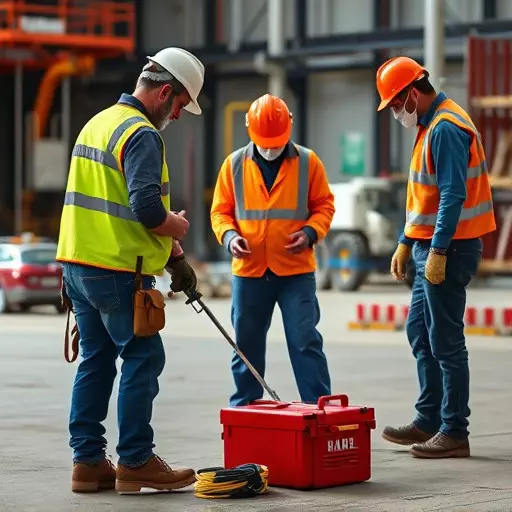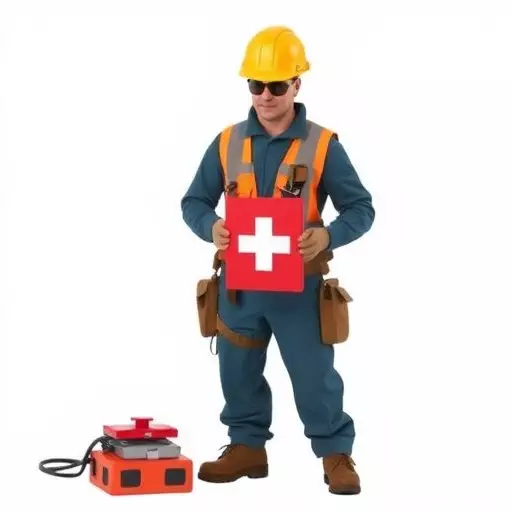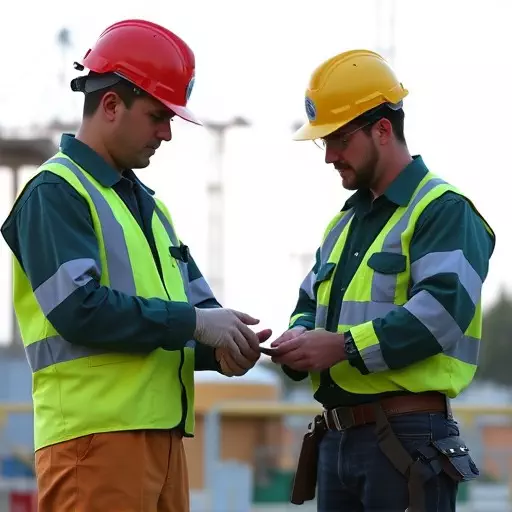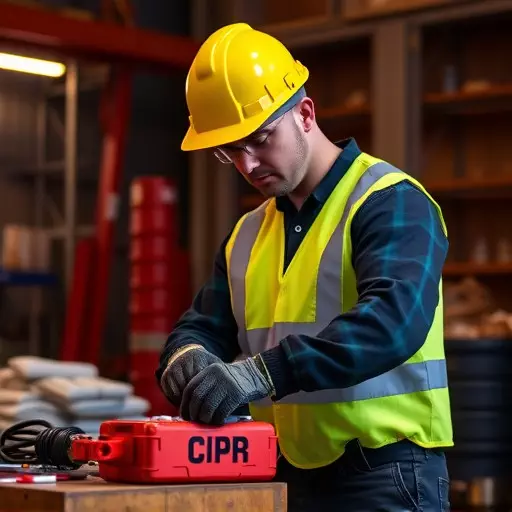Construction workers face heightened risks of traumatic incidents leading to cardiac arrest due to their job nature. CPR training, a legal OSHA requirement, equips them with essential skills for immediate response. They must recognize signs like lack of pulse and abnormal breathing, perform chest compressions (100-120 bpm) and rescue breaths, and maintain calmness during emergencies. Regular refresher courses are vital to update knowledge and follow latest guidelines, improving survival chances until professional help arrives.
In the high-risk environment of construction sites, trauma-related cardiac arrest poses a significant threat. Understanding this critical condition and knowing how to respond with Cardiopulmonary Resuscitation (CPR) can save lives. This article equips construction workers with essential knowledge and skills, covering OSHA requirements for CPR certification, first aid basics, recognizing cardiac arrest signs, effective CPR techniques, and the importance of continuous education. By mastering these aspects, construction workers become vital contributors to their site’s safety, ensuring prompt and effective responses during emergencies.
- Understanding Trauma-Related Cardiac Arrest: A Construction Worker's Perspective
- The Importance of CPR Training for Construction Workers
- OSHA Requirements for CPR Certification: What Every Worker Needs to Know
- First Aid Basics: Essential Skills for Construction Site Emergencies
- Recognizing the Signs: How to Identify Cardiac Arrest in a Co-worker
- Hands-On Practice: Effective CPR Techniques for Traumatic Situations
- Continuous Education and Refresher Courses: Staying Prepared and Compliant
Understanding Trauma-Related Cardiac Arrest: A Construction Worker's Perspective

Construction workers often face unique risks on the job that can lead to traumatic injuries and potentially life-threatening situations, including cardiac arrest. Understanding trauma-related cardiac arrest is crucial for these professionals as it can occur due to various reasons such as severe bleeding, severe burns, or blunt force trauma. These conditions can disrupt the body’s normal heart function, leading to a sudden cessation of blood flow to critical organs.
CPR training for construction workers is essential and often required by OSHA (Occupational Safety and Health Administration) for maintaining a safe work environment. The first aid basics include recognizing the signs of cardiac arrest, such as lack of pulse or abnormal breathing, and promptly initiating CPR. Construction workers should be equipped with the knowledge to perform chest compressions at a rate of 100-120 beats per minute and allow air exchanges during rescue breaths. Staying calm under pressure is vital, as effective communication and coordinated efforts among team members can significantly improve survival chances during traumatic incidents.
The Importance of CPR Training for Construction Workers

Construction sites are often high-risk environments where accidents can occur suddenly and unexpectedly. Given the physically demanding nature of construction work, it’s crucial for workers to receive comprehensive first aid training, with a particular focus on Cardiopulmonary Resuscitation (CPR). CPR training for construction workers is not just an important safety measure; it’s also a legal requirement as per Occupational Safety and Health Administration (OSHA) guidelines.
Knowing the first aid basics for construction workers can significantly improve response times during emergencies, potentially saving lives. OSHA requires that employers provide their employees with access to emergency medical services and train them in CPR certification. This training equips workers with the skills to handle trauma-related cardiac arrests, which are common on construction sites due to the risk of falls, crush injuries, or other severe traumas.
OSHA Requirements for CPR Certification: What Every Worker Needs to Know

In today’s world, especially in high-risk industries like construction, knowing how to perform cardiopulmonary resuscitation (CPR) can be a matter of life and death. For construction workers, cpr training for construction workers is not just recommended but mandated by Occupational Safety and Health Administration (OSHA) requirements. These regulations emphasize the first aid basics for construction workers, ensuring they are equipped to handle medical emergencies until professional help arrives.
Construction sites pose unique challenges due to their dynamic nature and potential for trauma. OSHA’s guidelines for CPR certification specify that workers must be trained in basic life support (BLS), including CPR, and have the knowledge to identify and respond appropriately to various medical emergencies. Regular refreshers are also crucial to maintain proficiency, as these skills can make a significant difference in survival rates during traumatic incidents on the jobsite.
First Aid Basics: Essential Skills for Construction Site Emergencies

For construction workers, knowing First Aid Basics and being certified in CPR (Cardiopulmonary Resuscitation) is not just recommended—it’s essential. In the event of a traumatic cardiac arrest on a construction site, quick response can save lives. CPR training for construction workers equips them with the skills to handle such emergencies effectively until professional medical help arrives.
Understanding OSHA (Occupational Safety and Health Administration) requirements for CPR certification further underscores its importance. Employers are mandated to provide a safe work environment, including emergency preparedness. By ensuring that their workforce is trained in CPR, employers comply with OSHA guidelines, fostering a culture of safety on the construction site. This proactive approach not only meets legal obligations but also demonstrates commitment to the well-being of every worker.
Recognizing the Signs: How to Identify Cardiac Arrest in a Co-worker

Recognizing the signs of cardiac arrest is a critical skill for anyone, especially those in high-risk environments like construction sites. Construction workers should be able to identify key indicators such as sudden collapse, lack of breathing or normal breathing sounds, and unresponsiveness. These symptoms can indicate a cardiac emergency, requiring immediate action.
CPR training for construction workers is not only recommended but often mandated by OSHA requirements for first aid certification. Understanding the basics of first aid, including CPR, enables workers to respond effectively in emergencies. This includes performing chest compressions at a rate of 100-120 beats per minute and allowing for rescue breathing if trained to do so, which can significantly increase survival rates until professional medical help arrives.
Hands-On Practice: Effective CPR Techniques for Traumatic Situations

Hands-on practice is paramount in learning effective CPR techniques for traumatic situations, especially for construction workers who often encounter high-risk environments. The OSHA (Occupational Safety and Health Administration) requires that construction companies provide first aid training, including CPR certification, to their employees. This involves mastering the basics of first aid, understanding the signs of a traumatic cardiac arrest, and practicing the correct compression techniques.
Regular simulations and drills allow workers to hone their skills in a controlled setting. These exercises should cover various scenarios, such as bleeding control, airway management, and the application of automated external defibrillators (AEDs). By engaging in frequent hands-on practice, construction workers can enhance their readiness to respond effectively during real-life emergencies, potentially saving lives on the jobsite.
Continuous Education and Refresher Courses: Staying Prepared and Compliant

Continuous Education and Refresher Courses are vital components of maintaining proficiency in CPR for trauma-related cardiac arrest, especially for construction workers who face unique risks on the job site. Construction sites present numerous hazards that can lead to sudden cardiac arrest (SCA), making it crucial for workers to be well-prepared. OSHA requirements mandate regular CPR certification renewals, ensuring that construction professionals stay up-to-date with the latest techniques and guidelines. These refresher courses not only help individuals retain knowledge but also familiarize them with advancements in first aid basics.
Attending these educational sessions allows construction workers to stay compliant with industry standards while enhancing their ability to respond effectively during emergencies. By regularly updating their skills, they can confidently manage trauma-related cardiac arrests until professional medical services arrive. This proactive approach saves lives and contributes to a safer working environment for everyone on the construction site.


